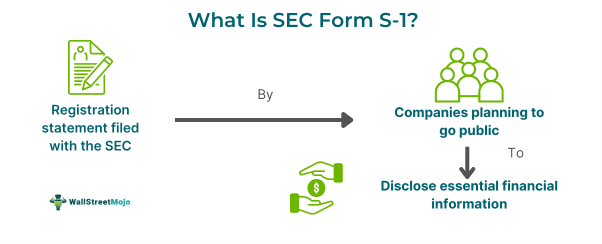Table of Contents
What Is SEC Form S-1?
SEC Form S-1 is the initial registration form required for new securities offerings in the United States, as mandated by the Securities and Exchange Commission (SEC). Companies planning to go public and list their shares on a national exchange must file this form.

The S-1 filing is a comprehensive disclosure document that provides detailed information about the company's financials, business operations, risk factors, and other relevant data. It is required under Section 5 of the Securities Act of 1933 and is essential for companies conducting an initial public offering (IPO) to ensure transparency and inform potential investors.
Key Takeaways
- SEC Form S-1 represents the initial registration for new securities before listing them on a U.S. exchange. It is mandatory for U.S. publicly listed firms and serves as a qualifying benchmark.
- It requires information related to the issuer's Employer Identification Number (EIN), principal executive offices, tentative sale date, business and financial details, name, jurisdiction, and an investment prospectus for investors.
- Issuers file Form S-1 using the EDGAR system, apply for a Central Index Key (CIK) and follow the quick reference guides.
- Issuers must file Form S-1/A to amend SEC Form S-1, ensuring compliance with the Securities Act of 1933 while disclosing vital information to investors to prevent fraud.
SEC Form S-1 Explained
The Securities and Exchange Commission (SEC) requires SEC Form S-1 filings, or registration statements, for domestic companies issuing new securities to the public. However, companies don't need to offer shares through private placements. The instructions for SEC Form S-1 provide detailed guidelines on the format and disclosure requirements that issuers must follow in accordance with Section 5 of the Securities Act of 1933. Only after meeting the criteria of Section 5 can companies offer new securities to the public.
Regulation S-K and Regulation S-X govern the contents of Form S-1. Regulation S-X dictates the content and format of financial reports within the registration statement, while Regulation S-K regulates all other required disclosures. SEC Form S-1 consists of two parts:
Part I
This section, often referred to as the prospectus, includes the primary disclosures required by the SEC. It provides comprehensive information about the issuer's financials and business operations, including the Management's Discussion and Analysis (MD&A), selected financial data, and risk factors. It also includes summaries of the company's business operations, income statement, pro forma financial details, and balance sheet. Additionally, it requires the disclosure of audited per-share data, balance sheets, and income statements to prevent securities fraud lawsuits.
Part II
This section includes supplemental information that the SEC may optionally disclose. It typically covers recent private placements of securities, additional financial information, and costs incurred by the issuer in conducting the offering.
Requirements
Form S-1 of the SEC requires specific information about the business and finances of the issuer, including the following:
- The exact name of the registrant is specified in its charter.
- The issuer's jurisdiction or state of incorporation.
- The issuer's Employer Identification Number (EIN).
- Details of the principal executive offices, including their addresses and official phone numbers.
- The proposed date for initiating the public sale of the securities.
- An investment prospectus is provided to all potential investors so they can make informed investment decisions. The prospectus must contain the following information:
a) Summary Information
b) Risk Factors
c) Ratio of Earnings to Fixed Charges
d) Use of Proceeds
e) Plan of Distribution
f) Description of the Securities to be Registered
g) Names of Counsel and Experts
h) Information on Financial Data, Business Operations, Legal Proceedings, and Properties
i) Information about Executive Officers and Directors
j) Qualitative and Quantitative Disclosures about Market Risk
k) Any Material Changes in the Firm's Affairs since the end of the latest fiscal year
l) The most recent Annual Report of the registrant
How To File?
Companies can file SEC Form S-1 using the Electronic Data Gathering, Analysis, and Retrieval (EDGAR) system as per SEC requirements. To begin, companies or individuals must fill out an identification form or an electronic form to apply for a Central Index Key (CIK), which provides access codes needed to file Form S-1 on EDGAR.
EDGAR filers can refer to quick reference guides that offer comprehensive instructions on performing all necessary steps, answers to frequently asked questions, and technical specifications. Filers need to complete both Part I and Part II of Form S-1 on EDGAR.
Additionally, issuers must pay registration fees to the SEC. These fees are calculated based on the number of securities being offered, the maximum offering price per unit, and the total maximum offering price.
How To Amend?
If an issuer wants to amend the SEC Form S-1, they must file Form S-1/A. This may be necessary in cases of delays, material changes, or changes in market conditions. These amendments are required to comply with the Securities Act of 1933, also known as the Truth in Securities Law. By filing Form S-1/A, issuers ensure that they disclose vital information while registering their securities, providing investors with accurate information and helping to prevent fraud.
Examples
Let us understand the topic using a few examples.
Example #1
An online article published on June 29, 2024, discusses the SEC's return of S-1 forms to the issuers of Ethereum ETFs, with notes for revisions and comments. Issuers are required to address these comments and refile the forms by July 8. This is part of a two-step approval process, the first part of which involved the approval of the issuers' 19b-4 forms in May.
As a result, the issuers will need to go through at least one more round of S-1 filings before the ETFs can become effective, making a July 4 launch unfeasible. Additionally, SEC Chair Gary Gensler has stated that Ethereum ETF approval could occur during the summer, though an exact timeline has yet to be provided.
Example #2
Let us assume that Greener Technologies Corporation is a company located in Old York City. It plans to offer an initial public offering (IPO) of its shares and get listed on the Old York Stock Exchange. To do this, it consults a financial expert to file Form S-1 with the SEC prior to the offering. The company prepares an informative prospectus detailing the sale of 20 million shares of its common stock, with an expected price range of $10-$15 per share.
The capital raised from the IPO would enable Greener Technologies Corporation to expand its manufacturing facilities in Nevada and Arizona to meet the growing demand for its solar panels. The prospectus provides investors with detailed information about the competitive solar market, installation costs, government incentives, and social initiatives. After correctly and duly filing the Form S-1, Greener Technologies Corporation could launch its IPO and raise the necessary funds.

